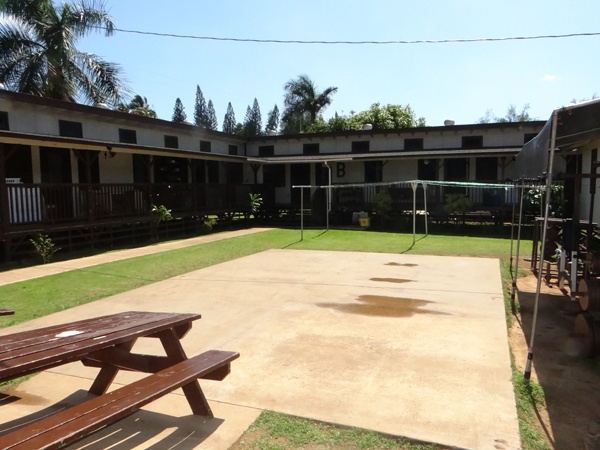WAILUA — The Legislature provided $5 million in planning money for a replacement jail on Oahu, and $1.5 million to Maui — but funding for Kauai and the Big Island will have to wait another session, according to the state
WAILUA — The Legislature provided $5 million in planning money for a replacement jail on Oahu, and $1.5 million to Maui — but funding for Kauai and the Big Island will have to wait another session, according to the state Department of Public Safety.
“Unfortunately, we have identified four facilities that need to be rehabilitated or replaced,” said Ted Sakai, director of the state Department of Public Safety. “Let’s just say we can’t wait too much longer. Can we do in five years? I hope we can. Can we wait 20 years? I don’t think so.”
Kauai Community Correctional Center is a multi-custody facility that replaced the former Kauai County Jail in 1978. It was the first county jail to make the transition after the state adopted a federally funded Correctional Master Plan in 1973.
The jail population averages 206 inmates daily. Starting with one building, the unorthodox KCCC has literally expanded piece-by-piece over the years to meet the demand for a growing population of inmates.
The goal is to incorporate what works at KCCC into a new facility that is out of the flood and tsunami zone and away from the highway.
“I think the drawbacks of the current facility far outweigh whatever benefits there may be,” Sakai said. “The benefit is the function of the leadership at the facility and the work of the staff we have there and the way they treat the inmates.”
KCCC Warden Neil Wagatsuma said the plan for a new facility should go beyond meeting the current needs and to prepare for the future.
“We will grow and the challenges will grow but this has to be so good that it should fill all the needs of this county for generations to come,” he said.
KCCC had very humble beginnings.
Former Lt. Llewellyn Lindsey started as an adult corrections officer on Oahu in 1969. He fought high blood pressure and nosebleeds from eight years of working in a high-stress environment where inmate violence was common and officers struggled to maintain control.
“There were a lot of battles, and it was a real rough place,” Lindsey said.
He started at KCCC in 1978 when there were only a couple of inmates housed in a main building designed for eight at the time.
“It was like day and night coming to KCCC,” he said.
The first KCCC Warden was John Smythe Jr. who served from 1978 to 1990. He hired Wagatsuma as a corrections counselor in 1986 and he would go on to become warden.
“As an outsider I had standard prison expectations and found that it didn’t have the same tension,” Wagatsuma said. “What was going on here was really different and this was completely good for me.”
The island spirit makes this place very different, he said. Everyone who has experienced the anger and noise of other jails and prisons will comment on how quiet it is here.
“A lot of these guys think of this as holy ground,” said Lt. Harry Victorino, an ACO with the modules rooms in the main building.
Modules A & B in the main building house six secure bays that surround a common area. The bays were designed to hold four people, then eight, and now house a dozen or more on bunk beds and floor mats. The module non-program rooms have an air of idleness in contrast to rest of the jail, with inmates still in their civilian clothes, either waiting release, a transfer to prison, or admission into the program module. Participants in the module program rooms must apply and be accepted by fellow inmates and an ACO. The regimen of classes, Bible meetings and focus groups requires a positive attitude and constructive interaction.
“It’s about attitude, behavior and compliance,” Victorino said.
The ACOs say they want to see the inmates become redirected. They credit the warden’s daily, hourlong talks with creating a good atmosphere.
“It not about ‘us against them’,” said Lt. Robert Kato.
The most important component is peer counseling, Wagatsuma said.
“You won’t see this anyplace else and some people would say it is impossible,” he said. “A lot of people fail and that is the reality. There is always recidivism but our goal is to reduce it.”
The jail population continues to grow while the facility, structure and resources age, Lindsey said. A new facility would mean not having to scramble in survival mode.
“We send a lot of inmates to other facilities because we need to but we would like to work with them,” he said.
There are many schools of thought on reform, but Wagatsuma said the way to address both penal and rehabilitative needs is to treat the criminality first and foremost.
“Some people want a chain gang and others want job training,” he said.
LTS Manager Sgt. Sia Salausa, said one source of rehabilitation is by instilling self-respect through cultural identity. He leads inmates in maintaining their own vegetable garden and orchard including taro plants, lemon grass and breadfruit trees.
“Its amazing that a lot of local kids over here have never done this in their whole life,” Salausa said. “I am happy to show them this part of their culture.”
Salausa said he was blessed with this knowledge from his grandparents and can now pass it on to others. He is confident that a new KCCC facility will have a larger agriculture area and more cultural programs.


